Pet owners today are increasingly turning to digital solutions to manage their pets’ needs, whether it’s finding a reliable dog walker, booking a pet sitter, or arranging grooming services. Apps like Rover have set the benchmark for on-demand pet care, combining convenience with trust. If you’re an entrepreneur or business looking to tap into this booming market, you might be wondering: How much is the cost to develop a pet care app like Rover?
In this comprehensive guide, we’ll break down the factors influencing cost, key features, tech stack, development process, and monetization strategies for creating a pet care app similar to Rover.
The Growing Demand for Pet Care Apps

According to recent reports, the global pet care market is projected to surpass $350 billion by 2027. The rise of pet humanization, busy lifestyles, and the increasing adoption of pets have fueled the demand for on-demand pet care apps like Rover and Wag!
Pet parents today expect:
- Instant booking of services
- Real-time updates
- Verified pet professionals
- Easy payment options
Hence, building a pet-sitting app like Rover isn’t just a trend—it’s a smart business move.
User Retention and Engagement Strategies for Pet Care Apps
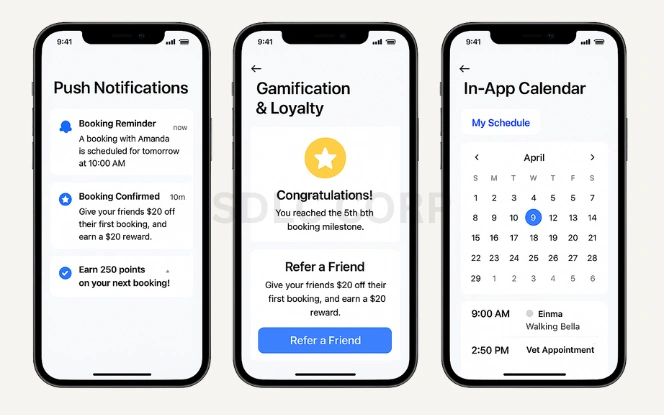
1. Personalized Push Notifications (with Smart Timing)
Send timely updates: booking reminders, appointment confirmations, and promotional offers.
Use behavior-triggered messages (e.g., “Time to rebook your favorite walker?”).
Avoid spamming—optimize send time using tools like Firebase or OneSignal.
2. Gamification and Loyalty Programs
Reward frequent users with points, badges, or discount coupons.
Allow users to unlock achievements like “5th booking milestone” or “Top pet parent badge.”
3. In-App Calendars and Service Reminders
Give users a “My Schedule” tab with vet appointments, walks, and grooming sessions.
Auto-sync with their phone calendar and enable repeat booking with a single tap.
4. Saved Preferences & Favorite Sitters
Let users save pet profiles, preferred sitters, or frequently booked services.
Enable “Quick Book Again” buttons to reduce friction and make the app feel personalized.
5. Email Nurturing Sequences
Use email for longer-form engagement: pet care tips, feature announcements, and seasonal promotions.
Segment your users (new vs returning) and personalize content accordingly.
6. Regular Feature Updates
Keep the app fresh by adding minor improvements or seasonal features (e.g., pet holiday gift packs, emergency vet button).
Notify users when new features launch to re-engage them.
7. Integrated Feedback Loops
After every service, prompt users to leave quick feedback.
Use NPS (Net Promoter Score) or micro-surveys to spot churn risks and improve the product iteratively.
Key Features to Include in a Pet Care App Like Rover

The cost of developing a pet care app like Rover is largely influenced by its features. Here are the essential ones:
1 User Registration & Profiles
- Pet owner profiles: Pet details (age, breed, medical needs)
- Service provider profiles: Background checks, certifications, experience

2 Search & Filters
- Find sitters, walkers, or groomers based on location, availability, ratings, and services.
- Service Type & Specialization Filters
- Instant Availability & Emergency Booking

3 Booking & Scheduling
- Calendar integration
- Real-time availability
- Instant or request-based bookings

4 Secure Payment Gateway
- Multiple payment options: credit card, digital wallets
- Transparent billing with a service fee breakdown

5 Live Tracking
- Track dog walks in real-time
- Updates during pet-sitting sessions

6 In-App Chat & Calls
- Safe communication between pet owners and service providers
- File & Photo Sharing
- End-to-End Encryption for Chats

7 Ratings & Reviews
- Build trust and maintain quality control
- Detailed Feedback Categories
- Photo & Video Reviews
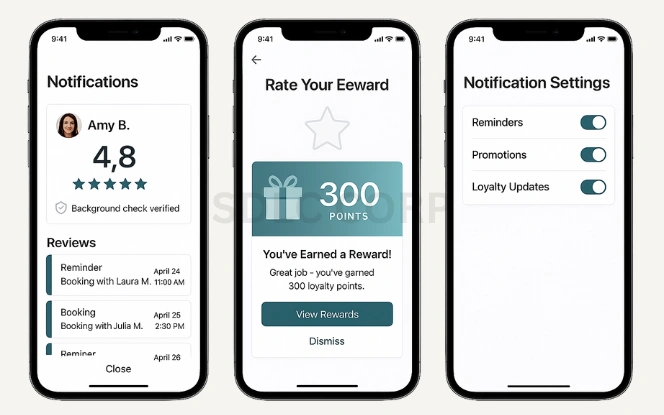
8 Push Notifications
- Reminders for bookings
- Promotions or loyalty rewards

9 Admin Dashboard
- Manage users, services, payments, disputes, and analytics
- Real-Time Analytics & Reports
- Dispute & Refund Management Tools

10 Additional Features
- Vet emergency contacts
- Pet supply ordering
- Pet health tracker
Adding advanced features like AI-based matching or AR-enabled virtual pet check-ins will increase the development cost, but can differentiate your Rover app clone in the market.
Explore: How Long Does it Take to Develop an App: Key Factors & Steps
Recommended Tech Stack for a Pet Care App Like Rover
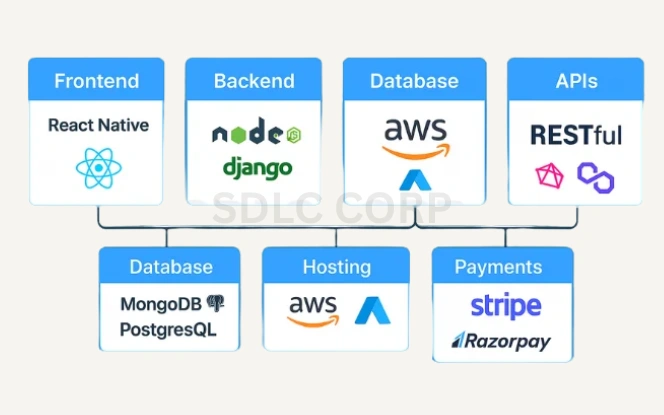
Choosing the right technology stack directly impacts development cost, scalability, and performance:
Layer | Technologies |
Frontend | React Native / Flutter (for cross-platform) or Swift (iOS), Kotlin (Android) |
Backend | Node.js / Ruby on Rails / Django |
Database | PostgreSQL / MongoDB |
Real-time features | Firebase / Socket.IO |
Payment Gateway | Stripe / PayPal / Braintree |
Cloud | AWS / Google Cloud |
Maps & Location | Google Maps API |
Push Notifications | Firebase Cloud Messaging / APNs |
Cross-platform frameworks like Flutter can reduce pet care app development costs as they allow a single codebase for both Android and iOS.
How Much Is the Cost to Develop a Pet Care App Like Rover?

| Development Stage | Estimated Cost (USD) |
|---|---|
| Discovery & Planning | $5,000 - $10,000 |
| UI/UX Design | $8,000 - $15,000 |
| MVP Development (basic features) | $25,000 - $50,000 |
| Advanced Features (real-time tracking, AI matching) | +$15,000 - $30,000 |
| QA & Testing | $5,000 - $10,000 |
| Deployment & Launch | $3,000 - $5,000 |
| Post-launch Support (per year) | $10,000 - $20,000 |
Timeline to Build a Pet Care App Like Rover

1. Start with an MVP (Minimum Viable Product)
Focus on core features only: sign-up, search, booking, payments, and basic profiles.
Skip advanced features like AI matchmaking, live video chat, or pet insurance integration at launch.
You can roll out premium features after validating your market and securing initial traction.
2. Choose Cross-Platform Development
Frameworks like Flutter or React Native let you build for iOS and Android using one codebase.
Reduces development time and future maintenance costs by 30–40%.
3. Use Third-Party APIs Instead of Building from Scratch
Integrate APIs for chat (Sendbird, Twilio), location (Google Maps), and payments (Stripe) rather than custom-developing them.
Saves backend engineering time and ensures reliability.
4. Prioritize Open-Source Tools
Leverage free or open-source libraries for UI components, pet profile forms, and admin dashboards.
Avoid paying for tools you don’t need at the MVP stage.
5. Offshore or Hybrid Development Teams
Hiring experienced teams from India, Ukraine, or Southeast Asia can cut development costs by over 50%.
Pair them with a local project manager if communication is a concern.
6. Use No-Code for Admin Panels
Tools like Retool or Outsystems let you build admin dashboards faster and cheaper than hardcoding them.
7. Negotiate Feature-Based Pricing
Ask development partners for modular pricing, so you can pause or scale up depending on your budget or investor funding.
Monetization Strategies for Pet Care Apps
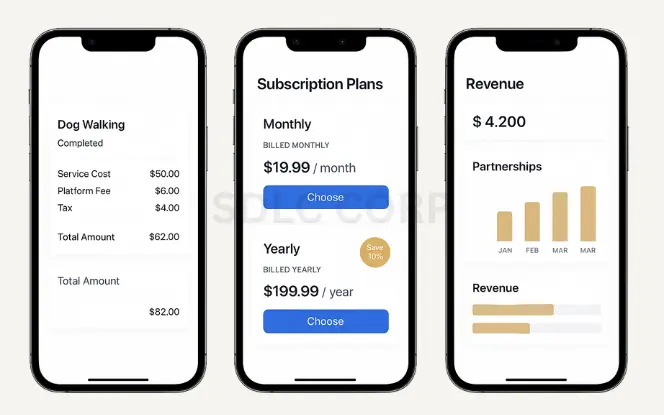
Service Fee / Commission
How it works: Take a percentage of each booking (e.g., Rover charges 15–20% from sitters).
Best for: Platforms that act as intermediaries between pet owners and service providers.
Scalability: Grows with transaction volume; low upfront friction for users.
Subscription Plans (Freemium + Premium)
How it works: Offer enhanced visibility, advanced booking tools, or marketing features to sitters in exchange for a recurring fee.
Examples: Profile boosts, analytics dashboards, priority listings.
Best for: Power users or professional pet sitters looking to scale their services.
Ad Placement
How it works: Display pet-related ads (vets, groomers, toys) using Google AdMob or direct partnerships.
Considerations: Must balance monetization with user experience.
Best for: Apps with high DAU (daily active users) and regional targeting capabilities.
Dynamic Pricing & Surge Fees
Inspired by: Uber-style pricing.
How it works: Increase prices during holidays, weekends, or high-demand periods.
Benefit: Incentivizes sitters to accept bookings and boosts platform revenue per transaction.
Marketplace Expansion (B2B or Multi-service)
Expand horizontally into related services:
Dog training, pet photography, pet taxi, grooming, or boarding.
Offer a multi-vendor marketplace (like Etsy for pets).
B2B Opportunity: Offer business dashboards for grooming salons or pet stores to manage bookings and customers.
Loyalty Programs & Gamification
Monetization angle: Retain users with points, badges, and perks for frequent usage or referrals.
Upsell: Offer paid tiers to access VIP rewards, early bookings, or concierge support.
Toolkits: Use gamification libraries or integrate with tools like Braze or CleverTap.
White-Label Solutions & APIs
Offer your app infrastructure as a white-label product to small pet care businesses or startups in other regions.
Alternatively, expose APIs for booking or sitter verification that third parties can license.
Factors That Influence Development Cost
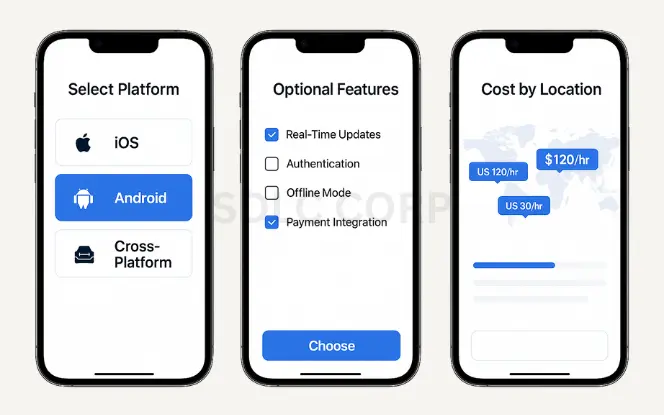
Platform Choice
The platforms you target play a pivotal role in determining your development timeline and cost structure.
Developing exclusively for iOS is often cheaper due to fewer device variations and a more consistent operating system.
Apple’s tools and environment (Xcode, SwiftUI) streamline the development process.
Slightly more complex due to fragmentation—more screen sizes, OS versions, and devices to support.
Might require extended testing and optimization, adding to the timeline and cost.
Design Complexity
UI/UX design directly impacts user engagement and development resources.
Focuses on usability with clean layouts and pre-built design systems.
Quick to implement and test with minimal custom styling.
Requires a dedicated design team to create unique, branded visuals.
Higher developer effort needed to replicate designs across platforms.
Feature Set
The functionality you want to offer defines both the scope and the complexity of the development process.
User registration, service search, pet profiles, booking system, messaging, and basic payments.
Can be launched within 3–4 months and tested with real users.
Each feature adds to development, testing, and maintenance efforts.
Enables platform owners to manage users, view data insights, and handle disputes or content moderation..
Why Invest in a Rover-Like Pet Care App?

- The pet tech market is booming
- Growing user trust in digital pet care services
- Low competition in many regions
- Opportunity to innovate with AI, AR, and IoT for pets
Security and Compliance Considerations

GDPR/CCPA Compliance: Include user consent, data portability, and right to erasure.
PCI-DSS for Payments: Ensure secure storage and transmission of card data.
Two-Factor Authentication (2FA) for user accounts.
Security Testing: Conduct penetration testing and regular vulnerability scans.
Privacy Policy and Terms of Use: Drafted by legal professionals and embedded in onboarding.
How to Get Started with Pet Care App Development
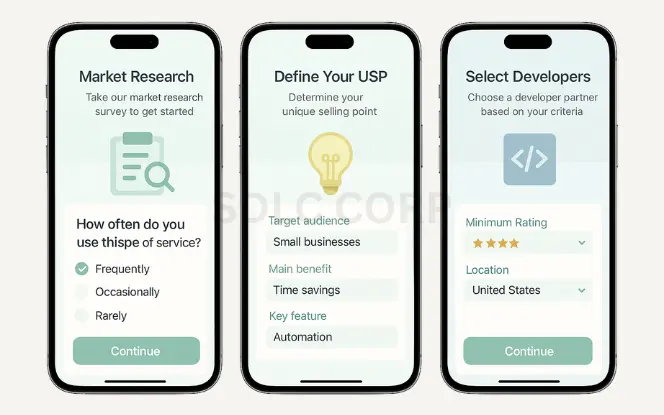
If you’re ready to build your pet care app, follow these steps:
Market Research: Understand your target audience
Define USP: What makes your app better than Rover?
Choose the Right Tech Partner: Look for app developers with experience in pet or service apps
Start with MVP: Test your idea before scaling
Plan Marketing: Build partnerships early
Conclusion
How much is the cost to develop a pet care app like Rover? As we’ve seen, it depends on your vision, features, and development strategy. A basic app can start at $40,000, while a fully loaded solution can cross $100,000.
Investing in a high-quality pet-sitting app like Rover can help you carve out a niche in a growing industry. Whether you want a dog walking app, a pet boarding app, or a comprehensive platform, the opportunity is ripe! Contact us. An experienced development company like SDLC Corp can help you navigate this journey efficiently, ensuring quality, scalability, and cost-effectiveness.
FAQ's
What Are the Most Important Features to Include in a Pet Care App Like Rover?
A pet care app like Rover should prioritize features that enhance convenience, trust, and safety for pet owners and service providers. Key features include user and pet profiles, service provider vetting, real-time tracking for dog walks, in-app chat and calls, secure payments, booking and scheduling tools, ratings and reviews, and push notifications. Advanced options like AI-based sitter matching, AR-enabled pet check-ins, and pet health trackers can add significant value and help differentiate your app in the market.
How Long Does It Take to Develop a Pet Care App Like Rover?
The timeline for developing a pet care app like Rover depends on its complexity. A minimum viable product (MVP) with basic features typically takes 3–4 months to build. A full-featured app with advanced functionalities such as live tracking, AI matching, and admin dashboards may require 6–9 months. The timeline can vary based on team size, location, and whether you opt for cross-platform or native development.
How Can I Monetize My Pet Care App?
There are several proven monetization strategies for pet care apps:
Service commission: Take a percentage from each booking (e.g., Rover charges 15-20%).
Subscription plans: Offer premium features for pet sitters or pet owners, such as enhanced visibility or additional tools.
In-app advertising: Partner with pet supply brands or services for ad placement.
In-app sales: Sell pet products, insurance, or accessories directly through the app.
Partnerships: Collaborate with vet clinics, pet stores, or grooming centers for affiliate income.
Does Using Cross-Platform Frameworks Like Flutter Lower the Development Cost?
Yes! Using a cross-platform framework like Flutter or React Native can significantly reduce development costs. These frameworks allow you to write a single codebase for both iOS and Android platforms, saving time and money compared to building two separate native apps. Cross-platform apps are ideal for startups aiming to launch faster while keeping budgets in check, without compromising on performance or user experience.
Why Should I Choose SDLC CORP for Developing a Pet Care App Like Rover?
SDLC Corp has extensive experience in building scalable, feature-rich, and cost-effective on-demand apps, including pet care and service marketplaces. The team provides end-to-end support—from ideation and UI/UX design to development, testing, and post-launch maintenance. With expertise in cutting-edge technologies like AI, AR, IoT, and cloud solutions, SDLC Corp ensures your app stands out in the competitive pet tech market. Plus, our flexible engagement models and global delivery teams help optimize costs while ensuring high quality.



